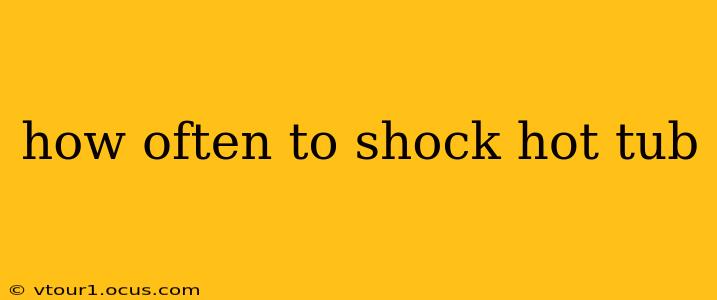Maintaining a clean and healthy hot tub is crucial for enjoying a relaxing and safe soak. Shocking your hot tub is a vital part of this process, eliminating contaminants that chlorine and other sanitizers can't handle. But how often should you do it? The answer isn't a simple number; it depends on several factors. This guide will walk you through the essentials, helping you establish a proper shocking schedule for your spa.
What is Shocking a Hot Tub?
Shocking a hot tub, also known as oxidizing, involves adding a chemical like calcium hypochlorite (cal hypo) or non-chlorine shock (potassium monopersulfate) to rapidly destroy contaminants like body oils, sweat, sunscreen, and other organic matter. These substances can combine with chlorine to create chloramines, which reduce the effectiveness of your sanitizer and can cause cloudy water, irritating odors, and even skin and eye irritation. Shocking boosts the level of free chlorine (or the oxidizing power in non-chlorine shock) to break down these contaminants and restore the hot tub's water balance.
How Often Should I Shock My Hot Tub?
The frequency of shocking depends on several key factors:
1. Hot Tub Usage: How Frequently is the Spa Used?
-
Heavy Use (Daily or Multiple Times Daily): With heavy use, shock your hot tub 1-2 times per week. The increased number of bathers introduces more contaminants, demanding more frequent oxidation.
-
Moderate Use (2-3 times per week): For moderate use, shocking once per week is generally sufficient.
-
Light Use (Once a week or less): If your hot tub sees infrequent use, shocking every 2-3 weeks or even monthly might be enough. However, always check your water chemistry before and after use.
2. Number of Bathers: How Many People Use the Hot Tub Regularly?
The more people using the hot tub, the more contaminants will be introduced. More bathers necessitate more frequent shocking to maintain water clarity and hygiene.
3. Environmental Factors: What is the Climate Like?
Outdoor hot tubs are exposed to elements that can contaminate the water. Hot, humid climates may require more frequent shocking due to increased algae and bacteria growth.
4. Water Chemistry: What Do Your Test Strips Tell You?
Regular water testing is paramount. If your test strips show low levels of free chlorine or high levels of total chlorine (indicating chloramines), it's time to shock the hot tub regardless of your usual schedule.
What Type of Shock Should I Use?
There are two main types of shock:
-
Chlorine Shock (Calcium Hypochlorite): This is a powerful oxidizer and a cost-effective option. Follow the manufacturer's instructions carefully as it can be harsh on spa components if used incorrectly.
-
Non-Chlorine Shock (Potassium Monopersulfate): A gentler alternative, this option is suitable for sensitive skin and doesn't increase chlorine levels. It's effective at oxidizing contaminants, but it's generally more expensive.
What if My Hot Tub Water is Cloudy or Smells Bad?
Cloudy water or unpleasant odors are strong indicators that your hot tub needs shocking immediately. Don't wait for your scheduled shock; treat the water right away.
How to Properly Shock Your Hot Tub
Always follow the manufacturer's instructions on your chosen shock product. Generally, you'll need to dissolve the shock in a bucket of water before adding it to the hot tub while the jets are running. Ensure the filters are clean before shocking. After shocking, run the jets for at least 30 minutes to ensure proper circulation.
Maintaining Your Hot Tub Water Balance
Shocking is just one aspect of hot tub maintenance. Regular water testing, balancing the pH, and cleaning or replacing filters are also vital steps in keeping your spa clean, healthy, and enjoyable.
This comprehensive guide offers a baseline understanding of how often to shock your hot tub. Remember, regular testing and observation of your water are key to ensuring the longevity of your spa and maintaining a clean and safe environment for relaxation. Consult your hot tub's manual for specific recommendations and always prioritize safety when handling chemicals.
